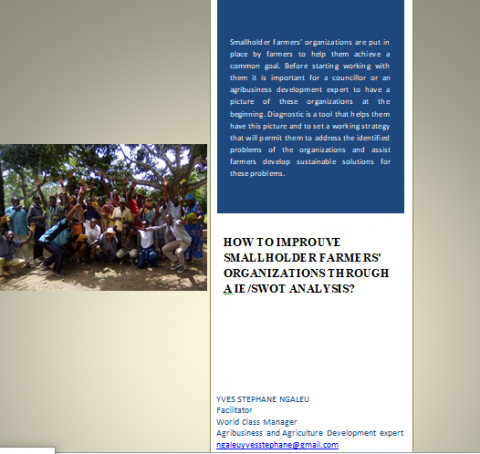Small holders or family farmers are small scale farmers, pastoralists and fishers who use mainly family labour for production and often produce for subsistence. They use part of their produce for family consumption and they manage areas varying from less than one hectare to 10 hectares. Some of them come together to form small holder farmers organisations (SHFO) to achieve common goals, this can be to ameliorate their productivities, their sales, the post-harvest management, the acquisition of input at better price or advocacy for a right, etc. Organizations generally render service to their members and impact the local communities in which they operate socially and economically such as cleaning their communities, providing loans for external members and assist under privilege etc. A small holder farmers’ organization can be a common initiative group, an association or a cooperative, etc. The functioning of the organisations is governed by internal and external factors. For a SHFO to function at the best of its potential it needs to take into consideration these factors. A diagnostic is then needed to collect information, analyse it and produce an Internal-External (IE) analysis also called SWOT (Strengths, Weaknesses, Opportunities and Threats) analysis. In this document focus will be laid on diagnostic, it is an essential element for SWOT analysis in smallholder farmers’ organizations.
Diagnostic is carried out in a smallholder farmers’ organization by a councillor or an agribusiness development expert at the beginning of his work with this organization. It will permit him to have the picture of the organization at that moment (before he begins working with the organization). The diagnosis is also carried after a certain period (after one year) of work with the organization to evaluate his impact.
A diagnostic is participatory, the councillor or the expert works with all the members of the organization to collect data on the external and internal factors. The expert observation is an access to identify elements related to decision making and involvement of members in the organization. The information collected and the observations will then permit him to bring out the picture of that organization at that particular moment, and with this information he can propose a consolidation and development/strategic plan for the growth of the organisation. The data collected and analysed should be presented to the organization for feedback. The feedback can be some modification, complementary information or that he has presented correctly the data collected. This presentation can be done through paper board if there is limited access to electricity or through a video projection if possible.
When collecting data, it is good to start with the organisation's life, then the internal factors and finally the external factors.
The organisation’s life
It is important to have an idea of the history of the organisation that is the creation and legalisation date, the purpose/motivation of its creation, its goal and its objectives, its legal status, the major changes in the organisation (it can be in activities, change of status, headquarter, number of members, etc.), its current structure (number of members, sex ratio, board members, etc.), its current activities (this is not members activities but the common activity of the group), etc.
Internal factors
These are factors that depend on the members and policy of the organization. These can be decision making process, the awareness rate of the constitution, the application and respect of the rules and regulations of the organization, existence of record/report of meetings, existence of a bank account, bank book record, a cash record, existence of social activities, accountability of board members, transparency in the organization, existence of a balance sheet and income statement, meeting frequency, existence of resources, etc.
External Factors
These are factors that depend on the environment in which the organization is operating. These can be the market places, the suppliers, the competitors, partners (technical, organisational and financial), the lobar forces, existence of thieves, climate conditions, government policy around the organization activities, etc.
After collecting these data, the councillor or expert can now ask the farmers the difficulties they face and what activity would they like to do if all the conditions are put together.
SWOT analysis
After collecting this information the councillor or expert will then group them following the S.W. O.T;
Strengths: these are internal factors of an organization that permit the growth and/ or the better functioning of this organization.
Weaknesses: These are internal factors of an organization that affect negatively the growth and/ or the better functioning of this organization, Weaknesses can be ameliorated.
Opportunities: these are external factors that can benefit an organization for its development and growth.
Threats: these are external factors that can affect negatively/prevent an organization’s development. These can be often overcome through alternative measures.
A councillor or expert can propose a development and strategic plan to help the organisation grow and this will be based on the weaknesses and Threats identified. Specific objectives will be grouped into general objectives. These general objectives can be programmed over three years. it can be done following these tables.
All the information collected and analysed should be presented to the organization, a paper board can be used or a video projector. From farmers’ feedback the document can be ameliorated, the finale document should be given to the organization for its utilization.
The councillor or the expert can now go further and collect information related to the economic and technical aspect of activities in the organization and fromm these data, a technical and economic diagnostic can be produced with a clear plan of action of the first year of working.


Comments
Combien de temps peut prendre un audit-diagnostic dans une exploitation agricole ?
Combien de temps peut prendre un audit-diagnostic dans une exploitation agricole ?